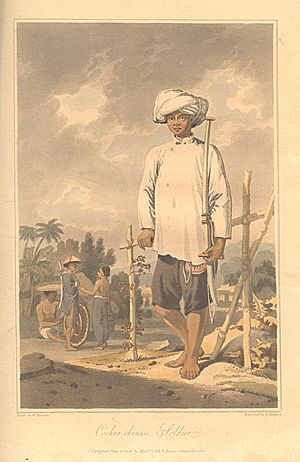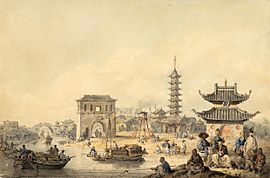William Alexander (painter) facts for kids
William Alexander (born April 10, 1767 – died July 23, 1816) was an English artist. He was a painter, illustrator, and engraver. His artwork was often done using watercolours. People loved his paintings for their clear, balanced colors and simple, elegant designs. He was known for his delicate lines and careful work. William Alexander went on an important trip to China in 1792. Many of his drawings were later made into prints.
Contents
Early Life and Art Training
William Alexander was born in Maidstone, Kent, England. His father, Harry Alexander, worked as a coachmaker. William went to Maidstone Grammar School.
When he was 15 years old, in 1782, he moved to London. There, he began to study art. He learned from two artists, William Pars and Julius Caesar Ibbetson. In 1784, he was accepted into the Royal Academy Schools. He worked very hard to become a skilled artist. A famous painter named Sir Joshua Reynolds noticed and approved of his talent.
Journey to China
In 1792, William Alexander was chosen for a special job. He became one of the artists for the Macartney Embassy to China. This was a diplomatic trip led by George Macartney, 1st Earl Macartney. William traveled with the Earl to Peking (now Beijing).
During this trip, he made many drawings. These drawings were later used for the pictures in a book about the embassy. The book was written by Sir George Thomas Staunton and published in 1797.
Returning Home and New Works
William Alexander came back to England in 1794. The next year, he married Jane Wogan, but she sadly passed away soon after.
He continued to create many important artworks. Some of his main works included:
- "Views of Headlands, Islands, etc. taken during the Voyage to China" (1798).
- Drawings for Vancouver's book Voyage to the North Pacific Ocean (1798). These were based on sketches by another artist named Daniells.
- Pictures for Sir John Barrow's books, Travels in China (1804) and Voyage to Cochin China (1806).
In 1805, he published a popular book called "The Costume of China. It had 48 colored pictures. Because it was so well-liked, he published another book in 1814. This one was titled Picturesque Representations of the Dress and Manners of the Chinese. It included 50 colored pictures and descriptions.
Besides his drawings, William Alexander also made several engravings. One of his most famous engravings showed a festival. It was given by the Earl of Romney to the Kentish Volunteers in 1799.
Working at Museums
In 1802, Alexander became a drawing professor. He taught at the Military College in Great Marlow. He left this job in May 1808.
Then, he took on a new role at the British Museum. He became the assistant keeper of antiquities. This meant he helped look after ancient objects. From 1810 to 1815, he made drawings of the terra cotta (baked clay) and marble items in the Museum. These drawings were later engraved and published in three books. The text for these books was written by Taylor Combe. William Alexander had even finished drawings for a fourth book before he passed away.
Later Life and Legacy
William Alexander died in July 1816. He passed away at his uncle's house in Maidstone. He was buried in Boxley churchyard.
People who knew him described him as a kind and humble person. They said he had a lot of knowledge about art. He was also known for being very honest.
To honor his artistic achievements, an exhibition was held in 1981. It was called "William Alexander: An English Painter in Imperial China. The exhibition was shown in Brighton and Nottingham.




